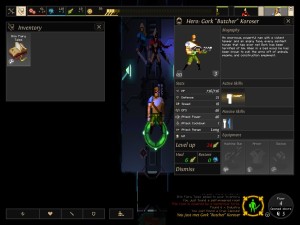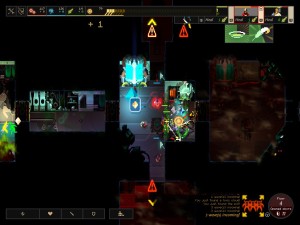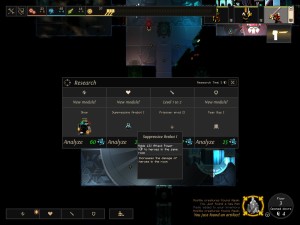Dungeon of the Endless by Amplitude Studios is an interesting mix of otherwise separate game genres. That combines the thrill of Rogue-like design with the methodical and often slower pace of a tower defense to make something entirely new. While the game is not finished yet, there is a lot to like here.
(The following spotlight is based on what is considered beta for Dungeon of the Endless and patch 0.8.7. Screenshots and details mentioned may not fully represent the full game or subsequent versions. I couldn’t find official notes on how frequent it is being patched but the developers are hoping to finish the game in 2014)
Rogue-Like Meets Tower Defense:
The plot is that a spaceship carrying prisoners crash lands on a mysterious planet and the survivors must get out of the ruins that their escape pod crashed into. Before you play a game, you’ll decide what escape pod your survivors were in and which ones you’ll control. The pod itself affects difficulty and unique conditions while the heroes are your main characters that you’ll control. The game boasts that you’ll unlock more heroes through play to increase the lineup which starts at three.
The game plays out in real time but has some turn base elements to it. How it works is that every time you open up a door on one of the randomly generated floors, a “turn” goes by. There are four main resources in the game that affect what are your potential strategies.
Industry which allows you to build new modules on the map, science that can be used to unlock new modules at specific points that can show up, food that can be used to level up heroes and heal them during combat and lastly dust. Dust is special in that you get it from killing monsters and finding it in the level and is critical to your survival.
Every ten points of dust gives you an energy point that you can use to light a room in the dungeon. Lighting a room gives it power that also powers any modules you may have installed there.
More importantly lighted rooms will not spawn enemies to attack you. It’s important to mention that you can power and depower rooms as you see fit but powered rooms have to be connected to each other.
With every turn, you’ll gain set points of the first three resources and there is a chance that enemies will spawn if there are any non powered rooms. The more rooms that are dark means the more enemies that will spawn and come after you. Like a tower defense game you have a point to defend and that is the power core located at the start of each floor. If an enemy attacks the power core you’ll lost dust which means losing the ability to power the floor and making it harder.
Have the crystal destroyed or get all your heroes killed and it’s game over. Heroes recover health after all the enemies are killed in a wave or you can use food as an emergency heal. Escaping a floor requires a mad dash with the power core to the escape as the rest of the rooms lose power and waves of monsters spawn to chase after you.
The combination of the rogue-like and tower defense mechanics also give Dungeon of the Endless a different feel to it.
A Fast, Methodological Pace:
What makes Dungeon of the Endless work for me is how different the game is thanks to its combination of genres. There is an interesting risk vs. reward dynamic in how you want to explore without over extending yourself and your supply of dust. The more you explore the greater the chance you’ll find new team mates, items or resources for upgrades. But then you risk making your escape that much harder or even dying before you get there due to the waves.
While the basic setup doesn’t change, the developers have several elements in place to add replayability and progression to Dungeon of the Endless.
Both heroes and escape pods can be unlocked through play: Heroes must survive three floors under your control after being found while pods have specific game conditions.
These forms of meta progression help provide some long term rewards and gives the developers an avenue for adding more replayability down the line. In game, the choices of modules to upgrade are randomized as you play which in turn changes how you’ll set up defenses when you need to.
What’s already in the game is pretty impressive but the game does have a few rough patches left to iron out before release.
Power Outage:
The UI is a bit cumbersome at the moment relying more on clicking buttons as opposed to hotkeys and keyboard commands. When combat does happen, things are a little too fast paced to be switching between multiple heroes and making use of their commands. There could also be more information being displayed as I had cases where enemies were barely scratching me and other times my heroes went from full to dead in an instant. Descriptions of items and modules make use of a lot of symbols that could do with a better description of what they do.
While the risk vs. reward aspect of Dungeon of the Endless is great at the start, it becomes more punishing as you get further into the game due to dust restrictions. With each floor you reach, the starting amount of dust you have decreases.
This means you can only set up fewer and fewer safe rooms and if you get unlucky with levels built around multiple paths, there’s just no way to adequately defend yourself.
Monsters go straight for your heroes and the crystal, leaving your modules unable to draw their fire (unless there is a module that I missed.) And you’ll find very quickly that monsters that spawn from dark rooms are a hell of a lot stronger than the normal monsters that were already there.
Every game that has ended in failure was based on the same pattern of not having enough dust to properly light the floor and being swarmed by waves of monsters with no way to stop them from mobbing my heroes. I do feel that there should be more advanced defense strategies to help compensate for the times where you do have to dig in and fight.
With that said, Dungeon of the Endless is an interesting game that manages to create something different from two unique genres. The design present is already pretty good and the game just needs that last push to make things perfect.
(For my final thoughts on Dungeon of the Endless, you can read my analysis)





